8 Things I'm Doing In 2024 Fantasy Football Drafts
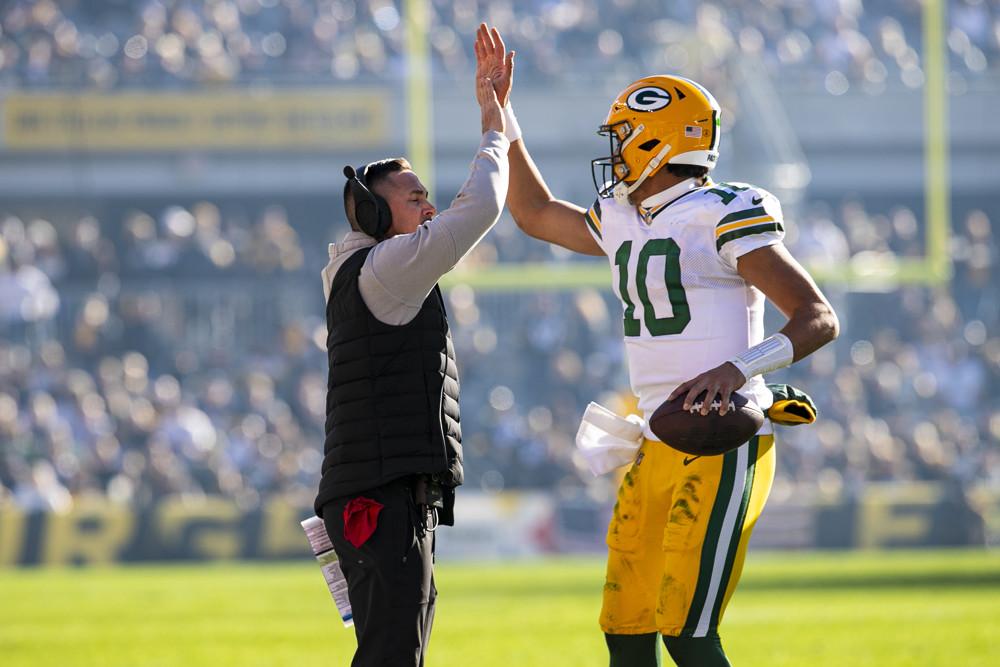
Best Ball Mania and Weekly Winners are about halfway filled up, as we head into the absolute peak of the fantasy football calendar. I've been grinding Underdog Fantasy employees only contests since the NFL Draft was completed, and I feel good about which strategies I want to deploy for the rest of the drafting calendar after experimenting with many builds. Here are my strategies for the 2024 season.
Fair warning: They're a lot different than in year's past.
1. I Get Weird From The 10th, 11th, and 12th Spot
There is a projections deficit from drafting late in the order this year, and I don't want to build the same (bad) teams as everyone else at the Round 1/2 turn. If I'm going down, I want to go down swinging. Because the Round 1/2 turn feels relatively weak, this is the perfect year to find unique pairings, which often means reaching on players. We just have to do it in smart ways, as doing so incorrectly will legitimately make you build the worst possible teams.
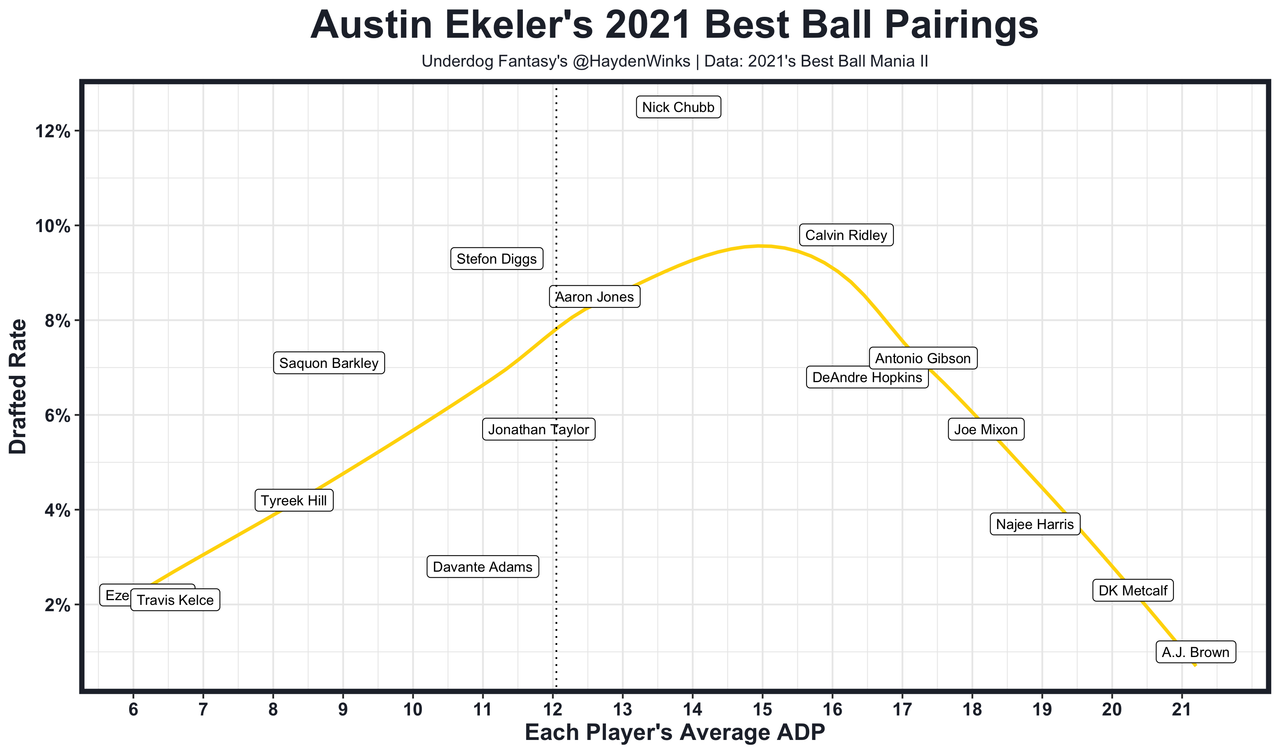
Let's use this chart I made in 2022 to visualize the science of unique pairings. Austin Ekeler was drafted 12th overall in 2021, and he was most commonly paired with the players ranked just after him in average draft position. Nick Chubb (14th in ADP) was on 12% of Ekeler teams. Calvin Ridley (15th), Aaron Jones (13th), and Stefon Diggs (10th) were all over-represented on Ekeler teams, too, just because they were frequently at the very top of the queue. Meanwhile, AJ Brown (21st in ADP) was paired with Ekeler just 2% of the time despite not being that much worse of a projected player than the Ridley types going ahead of him. Getting Ekeler paired with Brown was the smart way to build out of a relatively disadvantaged spot in the randomized draft order.

As you can see in my exposures from the 2nd round this year, I'm pulling up players in the back half of Round 2 and fading the early Round 2 players. I just don't think Marvin Harrison (13th in ADP), Drake London (14th), Jonathan Taylor (15th), and Chris Olave (16th) are much better -- if at all -- than the players going directly after them. I'll happily take the lower-drafted combination of players without sacrificing any projected points.
The exception is if I can get two of Puka Nacua, Garrett Wilson, and Jahmyr Gibbs on the same team. It doesn't happen often because it means another team is reaching in Round 1, but this is the best of both worlds: low-drafted combination of players and more projected points. Even if you like London > Wilson in a vacuum for example, you should be drafting Wilson when he's available after taking Nacua for uniqueness purposes.
We do have to be careful with reaching too far on players here, however. If we draft Mike Evans (23rd in ADP) and De'Von Achane (24th) at the Round 1/2 turn, then we've built a worse version of the lucky teams that have Christian McCaffrey and both of these players. Any player that could fall to the Round 3/4 turn or a pairing of players that can be drafted at the 2/3 turn are big nos when it comes to selecting them at the Round 1/2 turn.
2. I Often Have 7 WRs Through Round 13
I called having 4 WRs through Round 7 the "Golden Rule Of Best Ball" in years past, as it's been optimal or nearly optimal to do that in every year of Best Ball Mania. It's a strategy that intuitively makes sense because there are fewer late-round WRs that go crazy in fantasy compared to the other positions, but something has changed in 2024. Their costs. 72% of the first 3 rounds and 60% of the first 6 rounds are WR right now, despite them being about 47% of the starting spots on half PPR Underdog Fantasy. I don't have any issue with the Round 1 WRs, but pushing up the WR3 tier ahead of the elite onesies and the fringe RB1s is too far to me ... and most doing player projections. See ESPN's Mike Clay or Fantasy Life's Dwain McFarland as examples:
This means I'm not hitting that 4 WRs through 7 round threshold nearly as often as I had in the previous best ball seasons because I'm not going to blindly follow a trend if it doesn't match up with the player projections for the upcoming season. I also don't want to punt the most or 2nd-most important position in fantasy football, which leaves me with one other option: draft WR depth earlier than my peers.
On teams with only 3 WRs through Round 7, my new goal is to get 7 WRs by Round 13ish. This gets me back to normal levels of WR talent despite having multiple detours in the Round 3-8 range. Just look at this funky little chart below. The dots show how many WRs best ball drafters have through each round. Only 16% of teams in last year's Best Ball Mania had 7 WRs through Round 13, while only 3% of teams had 8 or more WRs. That doesn't mean I have a ton of WR firepower, but it does give me more than the average builder at the very least. On these semi-late WR builds, I'm drafting 8 or 9 WRs almost every single time, which helps me stack quite easily.
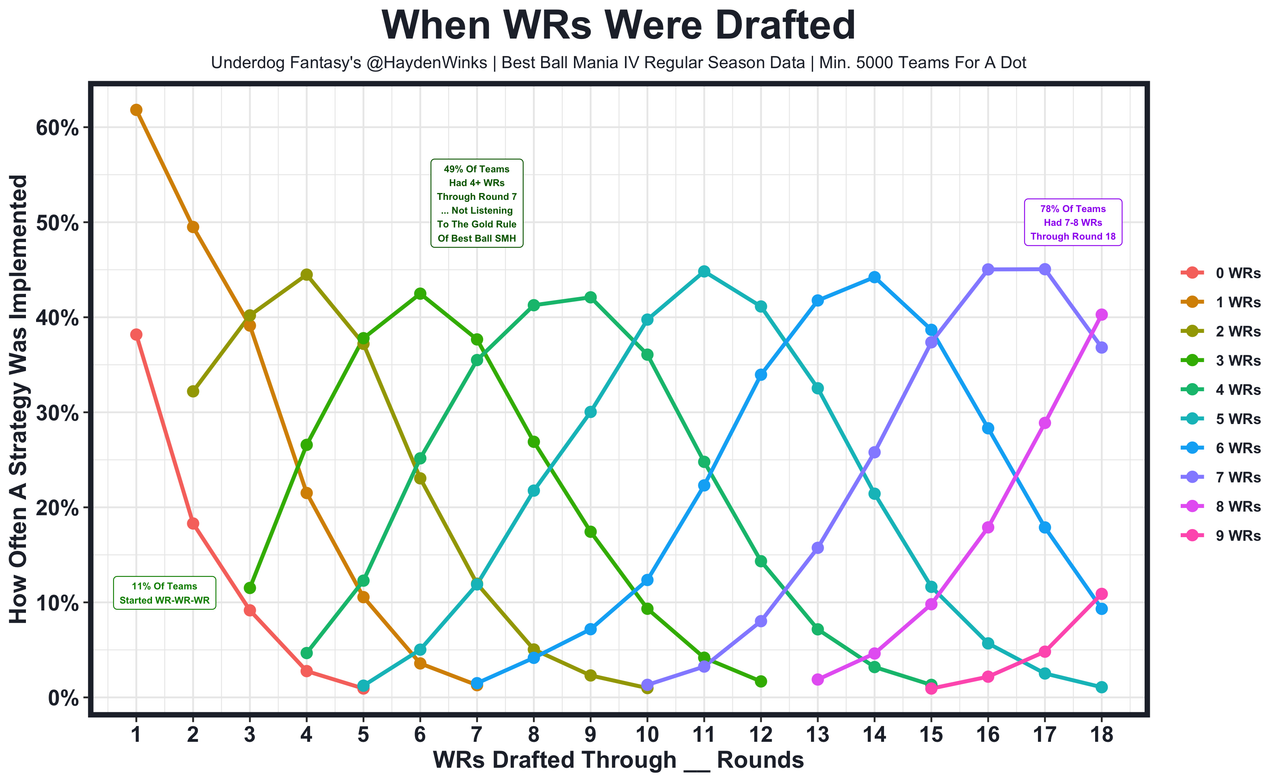
The last call for obvious potential upside at WR is in Rounds 11-13. That starts with size/speed receivers Dontayvion Wicks and AD Mitchell, then continues with obvious No. 2 WRs in Brandin Cooks and Jerry Jeudy, and finally wraps up with rookies Ja'Lynn Polk, Jermaine Burton, Xavier Legette, and Ricky Pearsall. These are often my WR5, WR6, and WR7. They provide enough rookie uncertainty or contingent-based upside to hopefully turn into a capable WR3/flex option during the fantasy football playoffs.
3. I Often Draft 4-RB Teams
26% of my teams have stopped at 4 RBs, compared to 8% of the field in 2023. It's an uncommon build nowadays after being popular in the earliest days of Best Ball Mania, but it does fit well with the strategy I listed above and today's ADP landscape. Spend up early, then completely halt before diminishing returns kick in. Here are two examples of when I have stopped at 4 RBs:
Kyren (3rd round), Josh Jacobs (5th), Rhamondre (7th), Zack Moss (9th)
Breece Hall (1st), Josh Jacobs (4th), Joe Mixon (7th), CEH (17th)
The first team started with WR-WR, but then I pivoted to a bunch of RBs while others pushed up the receivers. Only 20% of teams in last year's Best Ball Mania had 4 RBs through Round 9 like this team did (see chart below), so there's really no point in adding more after getting so far ahead. The second team started with potential legendary upside RB Breece Hall in the 1st round and had an RB3 in Round 7 (only 35% of teams had 3 RBs by then last year), so I was okay with staying with a 4-RB build despite having handcuff-only CEH as my 4th option.
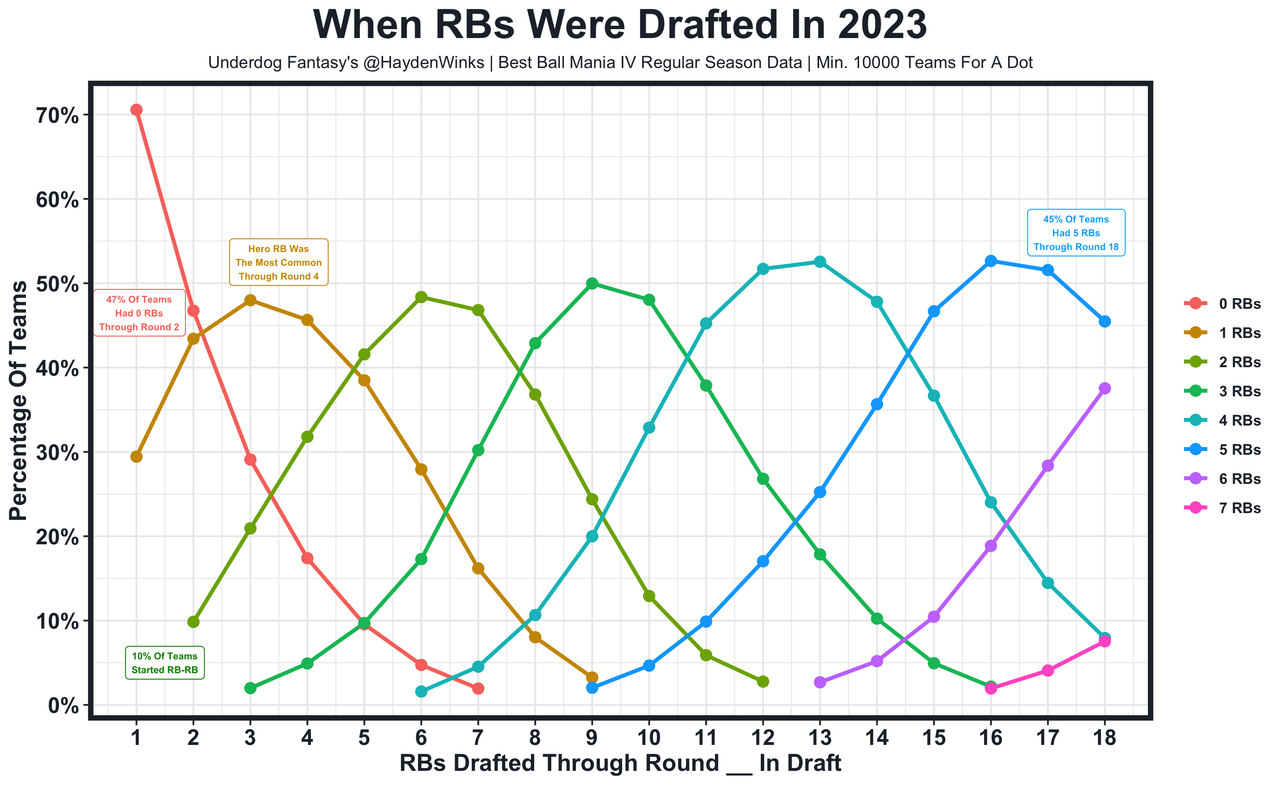
This strategy is a counter to two biases, too:
Recency bias: Early RB prices are considerably lower in 2024 after late-round RB went crazy in 2023. Does this happen every year? No. But humans weigh things that happen most recently with the most weight, often overstating the importance of the miniscule-sized sample ... And here's just how crazy the late-round RBs performed last season: I took every RB drafted in the 4 previous years of Best Ball Mania, then calculated the average score for the teams that drafted that RB to give them a percentile rank of how strong that player's season was at cost. I then looked at the RBs drafted after 120th overall in these 4 seasons (that's 185 RBs) to narrow the list to just late-round RBs, and then sorted them by how well their teams did. And 4 of the top-5 RB seasons came last year: Raheem Mostert (best late-round RB season), Kyren Williams (2nd), Zack Moss (4th), and De'Von Achane (5th). Only Jamaal Williams' 2023 season was in the same stratosphere of the late-round seasons we watched last year. I don't want to overreact to that outlier season.
Selection bias: There is evidence that users who draft more RBs early are doing unrelated negative EV things, like reaching ahead of ADP or not stacking enough. These things have nothing to do with drafting RBs on the surface, but it does mean that the sample of users who draft early RB teams aren't as informed as the Zero RB cabal. That means the non-contextualized data about drafting RBs early is likely under-selling the value of the strategy because we can draft RBs early while avoiding ADP reaches and stacking offenses properly. We also see the archetypes of RBs change based on if the user is taking a Zero RB or Robust RB approach, so we can build unique teams if we're willing to get into the minds of users who don't usually draft like us.
4. David Njoku Is An "Elite TE" ... To Me!
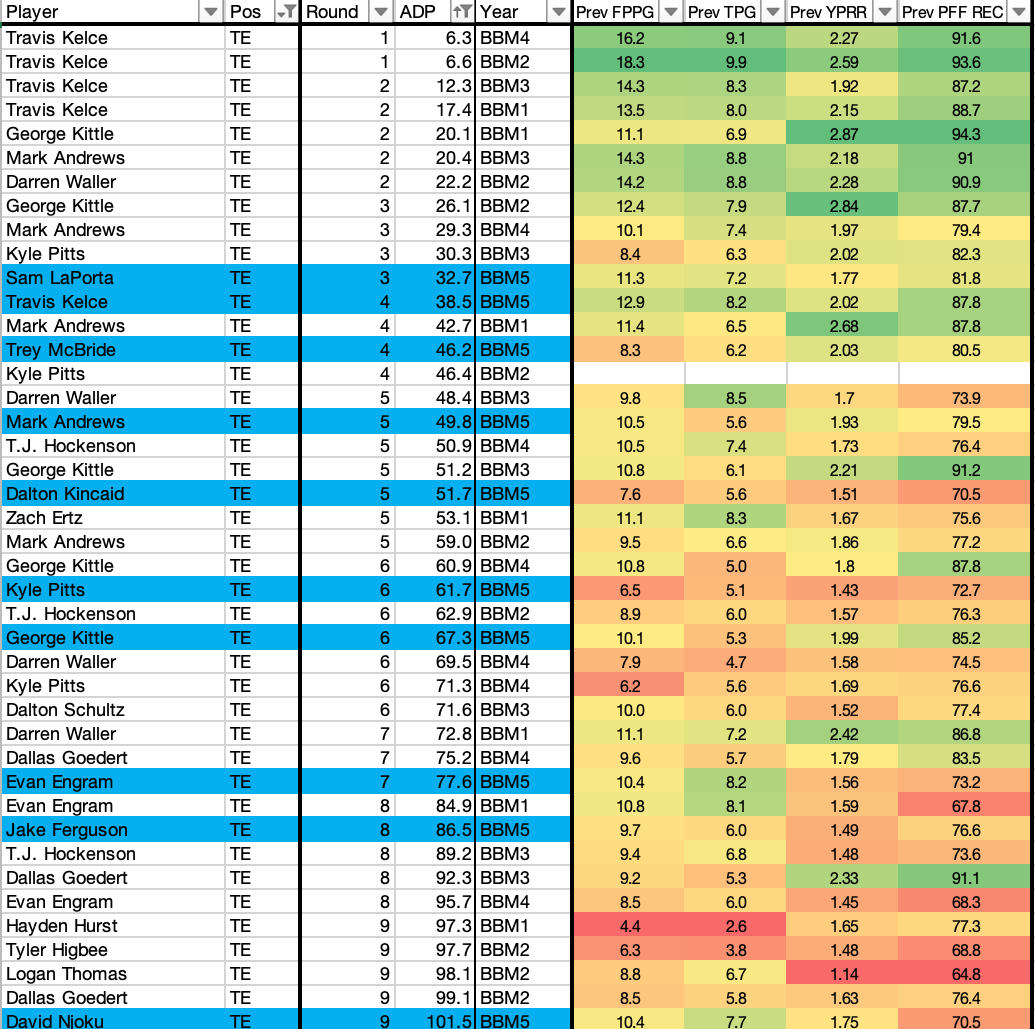
This is an ugly table (apologies), but there's some good stuff here. I promise. It compares all TEs drafted in the first 9 rounds of previous Best Ball Mania seasons to how well they did in various metrics during the previous season. This year's class is in blue.
I want you to focus in on 28-year-old David Njoku. He has the statistical profile of TEs who have been drafted in Round 5, particularly matching T.J. Hockenson's 5th-round selection from last year's Best Ball Mania. Njoku is very clearly good at football, then saw an uptick in targets once the Browns pivoted from a run-heavy offense with Nick Chubb to a pass-heavy offense without him. The Browns were 1st in neutral pass rate down the stretch of last year, a trend that many have overlooked this offseason. All of their offseason moves in recent years have signaled that they want to pass more.
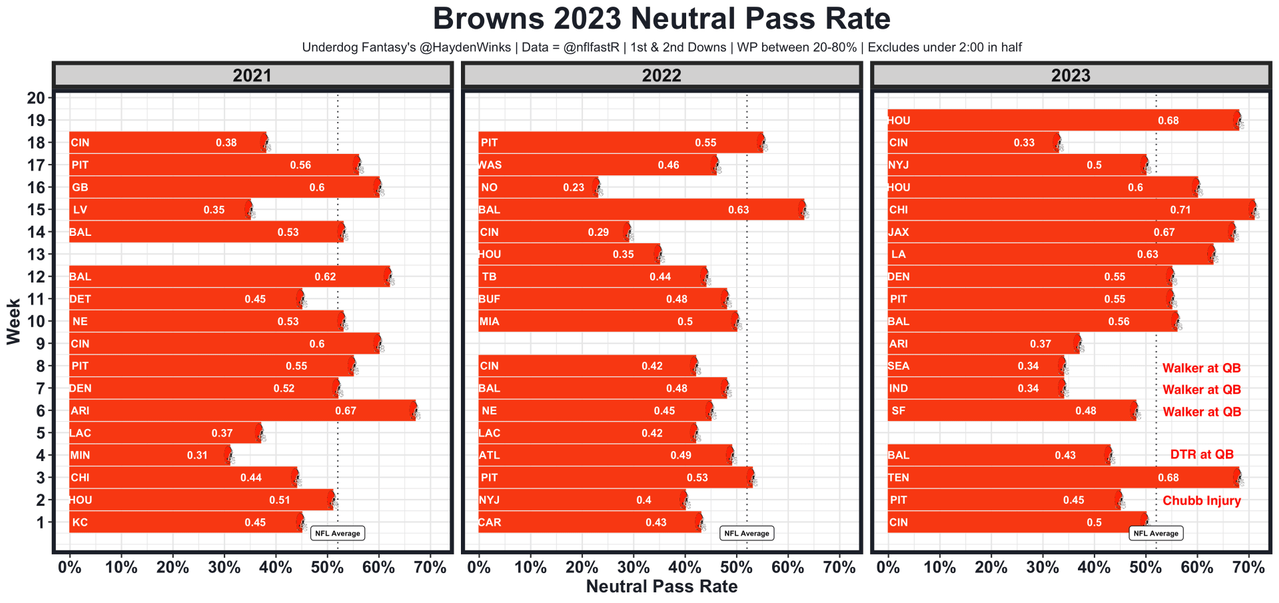
The counter to my bullishness is the on/off splits with Deshaun Watson. These are notoriously noisy and leave out a lot of context. Watson very well could be totally cooked, but that's largely priced in and it's possible that his shoulder injury was a big problem last year. I don't buy that Joe Flacco is actually better than Watson moving forward, despite their numbers last year. To ignore Njoku's TE1 overall stretch from Week 8 until the end of the season -- for real, he was the TE1 overall for more than half the year -- because of a sample size of 5 Watson games last year is missing the forrest for the trees, especially when Njoku had 19 targets in the 3 Watson games without Chubb.
I have 27% Njoku, as his ADP sits in Round 9.
5. I Only Draft Thicc RBs On Good Offenses
Here are my biggest RB exposures and where their offenses project in points this upcoming season: Josh Jacobs (10th), Zack Moss (7th), Derrick Henry (6th), Clyde Edwards-Helaire (3rd), Tyler Allgeier (13th), Kyren Williams (12th), Ezekiel Elliott (8th), Breece Hall (14th), Isiah Pacheco (3rd), Joe Mixon (9th), David Montgomery (2nd), Blake Corum (12th), Najee Harris (24th ... yuck), Marshawn Lloyd (10th), Rico Dowdle (8th), and De'Von Achane (5th).
The idea is simple: Big boys score goal-line TDs on good offenses in half PPR best ball without 100-yard bonuses. Oh, and we are allowed to put RBs into the flex.
6. I'm Loading Up On Rookie WRs
This was one of the best WR classes of all time, and I want to act on that, especially later on in the draft where the depth of the class can shine. Here are my biggest exposures and why:
WR44 Brian Thomas at 31%: The landing spot is underrated, especially if Trevor Lawrence plays better behind a slightly-improved offensive line. The Jaguars were 6th in plays, 6th in passes, 11th in neutral pace, 12th in neutral pass rate, and 11th in 4th-down aggressiveness. I respect Christian Kirk's game, but he isn't a stone lock to be the top target if Thomas is him. In college, he was. His size and speed combination is legitimately rare (95th percentile speed score), but Thomas' smoothness on tape was underrated and a potential sign that he can win in more ways than just gos, hitches, and posts. Even if he stays in a vertical-based role, Thomas can provide long TDs in half PPR best ball. I'm not ruling out a full-blown alpha takeover down the stretch. His best plays were terrific. Here's our video breakdown, and for those who like math, Thomas was a 94th percentile prospect in my model.
WR64 Ja'Lynn Polk at 28%: The Patriots' WR1 goes significantly later than any other team's WR1, leaving plenty of room for upside if someone runs away with target share. Polk has the easiest path to playing time because he's a versatile player who is ready made, a la Robert Woods or Josh Palmer. There's some upside in Drake Maye completely changing the dynamics of the offense late in the season, while Jacoby Brissett has an argument for the most underrated "backup" QB in the NFL. He brings stability.
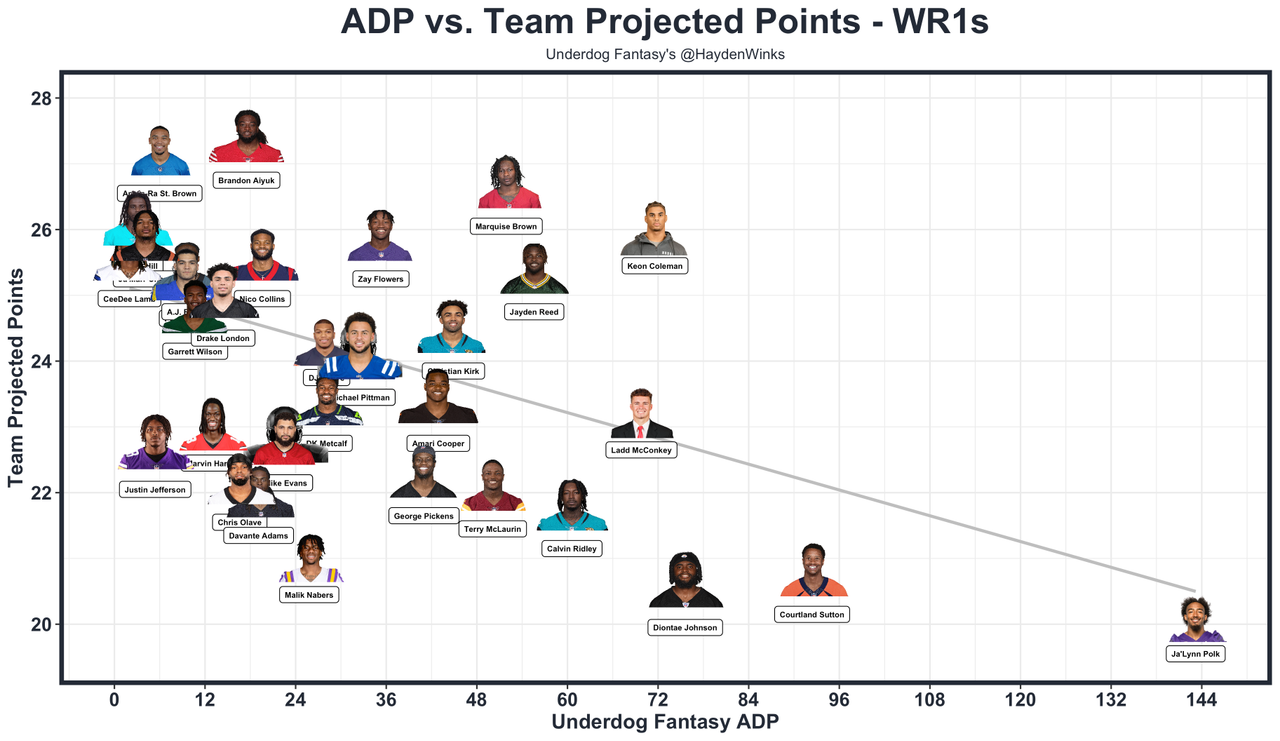
WR42 Ladd McConkey at 20%: What if Justin Herbert is really good behind a great offensive line? What if OC Greg Roman isn't as run heavy without Lamar and Kaepernick? What if McConkey, who led the Power 5 in EPA per route last year, is just really damn good? There are a lot of outs here, without a lot of target competition. McConkey's 4.39 speed and 90th percentile agility make him a tough matchup in man coverage and someone worth scheming up touches to underneath. I had a late Round 1 grade on him and love the landing spot. Our video on him is here.
WR70 Jermaine Burton at 16%: His tape was a lot of fun, even if his production was held back by a run-first QB at Alabama. Burton is a real deep threat but comes with more physicality and thiccness than the typical outside vertical player. He can break tackles over the middle and can beat man coverage on the line of scrimmage. The Bengals have a plan to maximize his on-field talent and have a No. 3 starting spot waiting for him. An occasional spike week is possible if the Bengals turn out to be the 5th-best offense like Vegas' projection, but there's upside beyond that if Ja'Marr Chase or Tee Higgins miss time. I thought he had early Round 2 talent. You can watch him here.
WR37 Xavier Worthy at 13%: The fastest player in NFL Combine history goes to the best QB in NFL history paired with one of the best play callers in NFL history. Let's see what happens, especially if Rashee Rice gets a 6-game suspension this season.
7. I Often Draft A QB3 In Rounds 16-18
This could be a product of doing these drafts before training camp news gives me more confidence in the RBs, WRs, and TEs who are available in the very last rounds, but I like these late-round QBs more than in year's past because there are some dual-threat options.
QB27 Daniel Jones at 19%: The late-season benching risk is somewhat real because of the injury-based guarantees, but if he's playing well with the best supporting cast of his career, then none of that matters. DJ has been an upside QB2 without receivers, and now he's upgraded with Malik Nabers, Jalin Hyatt, and Wan'Dale Robinson in recent drafts. Brian Daboll is still a solid coach and the Giants' defense still looks bad, so Jones could surprise in garbage time once again. It helps that Hyatt and Darius Slayton are ideal backdoor stacks when in a pinch.
QB29 Bo Nix at 9%: Most don't realize Nix averaged 28 rushing yards and 0.74 rushing TDs per game while at Oregon. He's a decent-enough athlete to scramble around during the Broncos' inevitable garbage time, plus has light's out passing numbers. He was 1st in PFF passing grade, 1st in turnover worthy play rate, 2nd in EPA, and 2nd in success rate after removing his screen and RPO attempts last year. It makes sense why Sean Payton wants a distributor type at QB after having so much success with Drew Brees. There are plenty of Nix stacking options available late in the draft, or we can snag alpha Courtland Sutton in the middle rounds.
QB31 Russell Wilson at 8%: The Steelers' offseason timeline and the beat reporters' offseason assessment give me confidence that Wilson will be the starter for most of, if not all, of this season. The offense won't be dynamic, but it stylistically fits what Wilson is still decent at: throwing the ball deep. His arm is still solid, and OC Arthur Smith will dial up under-center, play-action bombs to George Pickens. Hopefully Wilson's weight loss and change of scenery make him more mobile than he was in 2023. The Steelers' lack of pass weapons make this stack very narrow (Pickens, Pat Freiermuth, and Wilson), so there's less uncertainty on who to pair him up with.
QB25 Drake Maye at 7%: My expectation is Jacoby Brissett will start for the first half of the season, while the offense more-or-less holds tryouts at WR and across the OL. Let Brissett handle the worst of things before Maye comes in with a little more familiarity in a new system. Maye is unlikely to be a high advance rate player for that reason, but he does have the dual-threat ability and pedigree to have spike weeks late in the year. Maye's accuracy and decision-making were hit-and-miss, but his best throws, best pocket movement reps, and best scrambles were beautiful. You can watch our film breakdown of him here.
QB26 Bryce Young at 4%: I'm less optimistic with Young than the rest, but he can run around and at least has the pedigree of someone with a path to upside. He also pairs nicely with some middle and late-round WRs, a path I'm taking constantly in drafts. Young just has to make better decisions and showcase better arm talent. New play caller Dave Canales is likely to help his footwork issues immediately, but the Panthers are bad and will be run heavy.
As I wrote about in What Has Worked In Best Ball Mania In All 4 Years, the regular season difference in 2- and 3-QB builds is minimal and has fluctuated over the years. What has remained constant is that the 3rd QB shouldn't be drafted until Round 15 or later, as anything earlier than that messes with the law of diminishing returns. What the advance rate data doesn't include is the value of adding another team stack. In a perfect world, the QB1 would go nuts in Round 2 of best ball. Then the QB2 would go nuts in Round 3. Then this random low-owned QB3 would pop off in the finals. Establish The Run's Mike Leone has shared how valuable 3 stacks with a bring back are once we get to the finals.
8. I'm Stacking The In-Pocket QBs
The word "correlation" gets used a lot in best ball, but it's context isn't broken down often enough. There are different strengths of correlation based on position, based on team archtype, based on bring back vs. teammate, etc. Instead of blindly adding players for the sake of correlation, I'm being intentional in how I use correlation this season. The most obvious examples are 1) leaning into teammate correlations far more than Week 17 correlations, and 2) leaning into in-pocket QBs correlations more than ever.
While fantasy football playoff correlation is helpful, it is being used more than ever (increasing the combinational ownership of two players) and the flatness of the Week 17 payouts has shifted the value towards Weeks 15 and 16 more than ever. In general, there's slightly less reason to break ties in favor of Week 17 correlation, especially if I can build out another team stack instead or build around the less-stacked Week 15 and 16 games. This is a big driver of why I'm building out more 3-QB teams and fewer 6-RB teams. I want to chase the most correlation available: teammate QB to WR correlation. Right now, 92% of my teams have at least 3 different team stacks (minimum 2 players from the same team). I just wanted to stress how much more correlation there is between teammates compared to bring back options. The exact numbers are here.
There are differences between teammate correlation, too. Like mentioned above, the QB and his WR1 and WR2 have the most correlation at their ceilings in general. But just how much correlation they have and how many total pass-catchers the QB can bring along with him depends on how much passing volume is available in the offense. The more passing production, the higher odds the WR1 and TE1 get pulled up together. That's why I'm prioritizing in-pocket QBs more than ever. I simply want to be forced into getting fewer things correctly throughout my draft.
If I draft Jayden Daniels who is scoring a very high percentage of his own fantasy points on the ground, then I will have to draft more unstacked WRs and TEs later in my draft because I don't want to over stack a low-volume passer. But if I set up a Matthew Stafford stack, then I have the freedom to draft Puka with Kupp and Colby Parkinson because Stafford's elite seasons bring multiple pass-catchers along with him. I looked at the best QB seasons in Best Ball Mania history and found that Dak Prescott, Tom Brady, Justin Herbert , Brock Purdy, Aaron Rodgers , C.J. Stroud, Trevor Lawrence , Ryan Tannehill, Matthew Stafford , Tua Tagovailoa, and Kirk Cousins have each had 90th percentile or better teams as strict pocket QBs because of how many pass-catchers they've been able to elevate. This is particularly true in 2024 when rushing production is largely baked in. If I knew Daniels and Lawrence would score the same amount of fantasy points this year, I'd rather have Lawrence knowing my odds of hitting on his receivers are far higher than Daniels' are.
I'm specifically stacking these teams:
7.0% of my picks are Rams: The baseline for all 32 teams would be 2.9%, so I'm more than double the field on Sean McVay's players. That feels great. With Stafford and Kyren on the field together, the Rams were 2nd in EPA per play. That doesn't include all of those games when Cooper Kupp was clearly beat up, nor when Demarcus Robinson cracked the starting lineup and began to produce. Add in the Rams' beef on the interior line and the loss of Aaron Donald on defense, and we have the recipe for a monster season. It helps that the Rams have the highest projected team total of Week 17 as they host the Cardinals.
6.3% of my picks are Seahawks: Geno Smith is good. He just needs better luck, coaching, and offensive line play. Last year, Smith led the NFL in "lost" touchdowns to defensive pass interference calls in the end zone (4). The Seahawks also finished 25th in percentage of their red zone drives in touchdowns. That's a lot of touchdowns ready to flip over in Geno's favor. On top of that, new OC Ryan Grubb called a beautiful and translatable offense at Washington last year. He has a great 3-WR set and Noah Fant to work with. So if the OTs can stay healthy, we are ready to cook.
5.9% of my picks are Packers: I'm heavy on Josh Jacobs after watching Aaron Jones see RB4 opportunity during the Packers' elite stretch late in the year. From Week 12 on, Green Bay was 2nd in EPA per play after finally getting Christian Watson healthy and getting their rookies up to speed. Matt LaFleur is a top-5 play caller, who also seems to get the most out of their offensive line. The uncertainty among their WR room allows for hidden upside. My exposures are circling on Jacobs, Marshawn Lloyd, Dontayvion Wicks, and Luke Musgrave in particular.
5.6% of my picks are Cowboys: I wrote about them here.
5.3% of my picks are Chiefs: The Chiefs were 15th in scoring last year while holding WR tryouts for the entire season. Those issues are resolved with Hollywood Brown and Xavier Worthy. They're back to being projected for the 3rd-most points in the NFL, yet none of them are drafted in the first 3 rounds. It's time to fire.
4.6% of my picks are Jaguars: Anyone doing projections notices the Jaguars WRs and Trevor Lawrence are slightly undervalued. And those don't properly account for the obvious upside T-Law has if this newly-made offensive line gives him comfort. Christian Kirk is an underrated play-maker, especially if he's a No. 2 receiver. The upside of Brian Thomas as a breakout No. 1 is what I'm particularly in love with. Give me the 21-year-old 6'3/209 SEC dominators who have 4.3 speed. You can keep the YPRR route guys from lesser conferences with less athleticism.